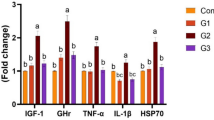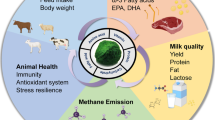Abstract
The use of algae as alternative feeds has long time attracted interest. However, due to excessive accumulation and variation in some of its components, difficulty in harvesting, and the need for some processes (cleaning, rinsing, drying, etc.) before final use, it causes hesitations about their use as feed. The feed values of Ulva lactuca and Cladophora glomerata collected from the same region in two different years (2020–2021) were investigated. The comparison of Ulva lactuca and Clodophora glomerata in two successive yearsyielded significant differences (P < 0.05) for crude protein% (22.23–10.78 and 18.38–12.85), crude ash% (19.28–34.10 and 40.67–35.51), ADF% (13.41–12.39 and 19.61–22.13), NDF% (39.18–36.35 and 29.36–35.74), calcium% (11.75–1.49 and 38.47–1.35), magnesium% (1.02–13.54 and 1.76–8.61), potassium% (0.53–6.17 and 1.50–17.86), sulphur% (4.76–2.41 and 3.41–1.80), and nickel ppm (9.50–87.5 and 20.25–105.3). Significant differences were also detected between other nutrients, minerals, energy, and digestibility values (P < 0.05). It has been determined that some heavy metal and mineral amounts are at restrictive levels at the point of use as feed. Aluminum (4982.7–7459.3 ppm) and silicon (8882.3–1449.3 ppm) were found in Ulva lactuca and Cladophora glomerata, respectively (P < 0.05). Sulphur, aluminum, silicon, and nickel amounts are above the tolarable feed criteria limits. Cadmium and lead were determined to be above the limits allowed in the legal legislation. Their biosorbent properties cause them to be affected by the ecosystem, and undesirable accumulations appear as a restrictive situation. Therefore, it is necessary to systematically determine their contents and variations. It was concluded that they are important in terms of potential feed value but should be used in a controlled manner.


Similar content being viewed by others
Data availability
On inquiry, the data presented in this study is available from the author.
References
Allen VG (1984) Influence of dietary aluminum on nutrient utilization in ruminants. J Anim Sci 59:836–844
AOAC (2009) Association of Official Analytical Chemists For the determination of nine nutritional elements in food products by inductively coupled plasma-atomic emission spectroscopy after microwave digestion(984.27). AOAC Off Method 92:1484–1518
AOAC (1997) Association of Official Analytical Chemists Fiber (acid detergent) and lignin in animal feed (973.18). AOAC Off Method 28–29
AOAC (2005) Association of Official Analytical Chemists Ash of animal feed, in official methods(942.05). AOAC Off Method 8
AOAC (2006) Association of Official Analytical Chemists Protein (crude) in animal feed, combustion method (990.03). AOAC Off Method 30–31
AOAC (2022) Association of Official Analytical Chemists Amylase-treated neutral detergent fiber in feeds (2002–4). AOAC Off Method 48–55
AOCS (2004) American Oil Chemist’ Society Rapid determination of oil / fat utilizing high temperature solvent extraction. 1–3
Arieli A, Sklan D, Kissil G (1993) A note on the nutritive value of Ulva lactuca for ruminants. Anim Prod 57:329–331
Ashour M, Mabrouk MM, Ayoub HF et al (2020) Effect of dietary seaweed extract supplementation on growth, feed utilization, hematological indices, and non-specific immunity of Nile Tilapia, Oreochromis niloticus challenged with aeromonas hydrophila. J Appl Phycol 32:3467–3479
Bailey CB (1977) Influence of aluminum hydroxide on the solubility of silicic acid in rumen fluid and the absorption of silicic acid from the digestive tract of ruminants. Can J Anim Sci 57:239–244
Beke GJ, Hironaka R (1991) Toxicity to beef cattle of sulfur in saline well water: a case study. Sci Total Environ 101:290–291
Bikker P, van Krimpen MM, van Wikselaar P et al (2016) Biorefinery of the green seaweed Ulva lactuca to produce animal feed, chemicals and biofuels. J Appl Phycol 28:3511–3525
Cabrita ARJ, Maia MRG, Oliveira HM et al (2016) Tracing seaweeds as mineral sources for farm-animals. J Appl Phycol 28:3135–3150
Çetingül V (2001) Cladophora glomerata ( L.) Kütz. ( Chlorophyta )’ nın amino asit içeriklerinin saptanması. Ege Üniversitesi Su Ürünleri Derg 18:107–109 (in Turkish)
Chojnacka K (2008) Using biosorption to enrich the biomass of seaweeds from the Baltic Sea with microelements to produce mineral feed supplement for livestock. Biochem Eng J 39:246–257
Coelho MS, da Souza Menezes B, Meza SLR et al (2016) Potential utilization of green tide-forming macroalgae from Patos Lagoon, Rio Grande-RS, Brazil. J Aquat Food Prod Technol 25:1096–1106
Cohen M, Neori A (1991) Ulva lactuca biofilters for marine fishpond effluents I ammonia uptake kinetics and nitrogen content. Bot Mar 34(475):482
Costa M, Cardoso C, Afonso C et al (2021) Current knowledge and future perspectives of the use of seaweeds for livestock production and meat quality: a systematic review. J Anim Physiol Anim Nutr (berl) 105:1075–1102
Dairy One (2022) Alfalfa nutrient content. Feed composition libraryWeb. https://www.dairyoneservices.com/feedcomposition/. Accessed 26 June 2022
Duygu DY, Erkaya İA, Sızmaz Ö (2019) Doğal tatlısu ortamlarından yığın halinde toplanan Cladophora glomerata ( Linnaeus) Kützing ve Mougeotia sp. türlerinin biyokimyasal komposizyonu. Aquat Res 2:24–31 (in Turkish)
Evans FD, Critchley AT (2014) Seaweeds for animal production use. J Appl Phycol 26:891–899
Fang L, Liu H, Xu Y (2006) Nutrition analysis about several edible algae in Xishuangbanna. Food Sci Technol 31:277–279
Feedipedia (2022) Seaweeds (marine macroagae) content. Animal feed resources information systemWeb. https://www.feedipedia.org/node/78. Accessed 27 June 2022
Guiry MD (2014) The seaweed site: information on marine algaeWeb. https://www.seaweed.ie/. Accessed 10 June 2022
Huang X, Li M, Xu B et al (2007) Proteasome and NF-κB Inhibiting Phaeophytins from the green alga Cladophora fascicularis. Molecules 12:582–592
Jousson O, Pawlowski J, Zaninetti L et al (2000) Invasive alga reaches California. Nature 408:157–158
Kharkwal H, Joshi D, Panthari P et al (2012) Algae as future drugs. Asian J Pharm Clin Res 5:1–4
Khuantrairong T, Traichaiyaporn S (2011) The nutritional value of edible freshwater alga Cladophora sp (Chlorophyta) grown under different phosphorus Concentrations. Int J Agric Biol 13:297–300
Lawton RJ, Cole AJ, Roberts DA et al (2017) The industrial ecology of freshwater macroalgae for biomass applications. Algal Res 24:486–491
Leliaert F, Coppejans E (2003) The marine species of Cladophora (Chlorophyta) from the South African East Coast. Nov Hedwigia 76:45–82
Li JY, Yang F, Jin L et al (2018) Safety and quality of the green tide algal species Ulva prolifera for option of human consumption: a nutrition and contamination study. Chemosphere 210:1021–1028
Makkar HPS, Tran G, Heuzé V et al (2016) Seaweeds for livestock diets: a review. Anim Feed Sci Technol 212:1–17
Mazlum Y, Yazıcı M, Sayın S et al (2020) Effects of two different Macroalgae (Ulva lactuca and Jania rubens) species on growth and survival of red swamp crayfish (Procambarus clarkii) as feed additive. Mar Sci Technol Bull 10:154–162
McAllister MM, Gould DH, Raisbeck MF et al (1997) Evaluation of ruminal sulfide concentrations and seasonal outbreaks of polioencephalomalacia in beef cattle in a feedlot. J Am Vet Med Assoc 211:1275–1283
Messyasz B, Leska B, Fabrowska J et al (2015) Biomass of freshwater Cladophora as a raw material for agriculture and the cosmetic industry. Open Chem 13:1108–1118
Michalak I, Chojnacka K, Dobrzański Z et al (2011) Effect of macroalgae enriched with microelements on egg quality parameters and mineral content of eggs, eggshell, blood, feathers and droppings. J Anim Physiol Anim Nutr (berl) 95:374–387
Mihranyan A (2011) Cellulose from Cladophorales green algae: from environmental problem to high-tech composite materials. J Appl Polym Sci 119:2449–2460
Misurcova L (2012) Chemical composition of seaweeds. In: Handbook of marine macroalgae: Biotechnology and Applied Phycology, 1rd edn. John Wiley & Sons, New York, pp 173–192
Moreda-Pineiro A, Pena-Vazquez E, Bermejo-Barrera P (2012) Significance of the presence of trace and ultratrace elements in seaweeds. In: handbook of marine macroalgae: Biotechnology and Applied Phycology, 1rd edn. John Wiley & Sons, New York, pp 116–170
Munir M, Qureshi R, Bibi M, Khan AM (2019) Pharmaceutical aptitude of Cladophora: a comprehensive review. Algal Res 39:101476
Naeem S, Hahn DR, Schuurman G (2000) Producer – decomposer influences biodiversity effects. Nature 403:762–764
National Research Council (1980) Mineral tolerance of domestic animals. The National Academies Press, Washington, DC
NRC (2001) Nutrient requirements of dairy cattle, seventh Re. National Academy Press, Washington, DC
Nutautaitė M, Vilienė V, Racevičiūtė-Stupelienė A et al (2021) Freshwater cladophora glomerata biomass as promising protein and other essential nutrients source for high quality and more sustainable feed production. Agric 11:582
Rey-Crespo F, López-Alonso M, Miranda M (2014) The use of seaweed from the Galician coast as a mineral supplement in organic dairy cattle. Animal 8:580–586
Roleda MY, Heesch S (2021) Chemical profiling of Ulva species for food applications: what is in a name? Food Chem 361:130084
Rupérez P (2002) Mineral content of edible marine seaweeds. Food Chem 79:23–26
Shi B, Lortscher P, Palfery D (2013) Algal biomass anaerobic biodegradability. J Appl Phycol 25:757–761
Sternberg SPK, Dorn RW (2002) Cadmium removal using Cladophora in batch, semi-batch and flow reactors. Bioresour Technol 81:249–255
Surayot U, Lee JH, Kanongnuch C et al (2016) Structural characterization of sulfated arabinans extracted from Cladophora glomerata Kützing and their macrophage activation. Biosci Biotechnol Biochem 80:972–982
Üçok S, Aybek A (2021) Büyükbaş hayvan dışkısı ve makroalg (Cladophora sp.)’den biyogaz üretimi. Mustafa Kemal Üniversitesi Tarım Bilim Derg 6:238–248 (in Turkish)
Valdivia R, Ammerman CB, Wilcox CJ, Henry PR (1978) Effect of dietary aluminum on animal performance and tissue mineral levels in growing steers. J Anim Sci 47:1351–1356
Van Soest PJ, Jones LHP (1968) Effect of silica in forages upon digestibility. J Dairy Sci 51:1644–1648
Vandermeulen H, Gordin H (1990) Ammonium uptake using Ulva (Chlorophyta) in intensive fishpond systems: mass culture and treatment of effluent. J Appl Phycol 2:363–374
Ventura MR, Castañón JIR (1998) The nutritive value of seaweed (Ulva lactuca) for goats. Small Rumin Res 29:325–327
Yabe T, Ishii Y, Amano Y et al (2009) Green tide formed by free-floating Ulva spp. at Yatsu tidal flat, Japan. Limnology 10:239–245
Zulkifly SB, Graham JM, Young EB et al (2013) The genus Cladophora kützing (Ulvophyceae) as a globally distributed ecological engineer. J Phycol 49:1–17
Acknowledgements
In this study, chemical analyses were carried out by the author in the feed laboratory of Kayseri Yem A.Ş. company. Mineral analyses were carried out by Aksaray University ASÜBTAM with the purchase of services. I would like to thank Erhan Şükrü Başyazıcıoğlu from Kayseri Feed Company for his support. I would also like to thank Prof. Dr. Murat Kaya from Aksaray University, who contributed with his experience and support.
Author information
Authors and Affiliations
Contributions
This study was done by the author.
Corresponding author
Ethics declarations
Ethics approval and consent to participate
Not applicable.
Consent for publication
Not applicable.
Competing interests
The author declares no competing interests.
Additional information
Responsible Editor: Philippe Garrigues
Publisher's note
Springer Nature remains neutral with regard to jurisdictional claims in published maps and institutional affiliations.
Rights and permissions
Springer Nature or its licensor (e.g. a society or other partner) holds exclusive rights to this article under a publishing agreement with the author(s) or other rightsholder(s); author self-archiving of the accepted manuscript version of this article is solely governed by the terms of such publishing agreement and applicable law.
About this article
Cite this article
Sırakaya, S. Pros and cons of Ulva lactuca and Cladophora glomerata grown in freshwater as feed. Environ Sci Pollut Res 30, 33446–33454 (2023). https://doi.org/10.1007/s11356-022-24532-1
Received:
Accepted:
Published:
Issue Date:
DOI: https://doi.org/10.1007/s11356-022-24532-1




